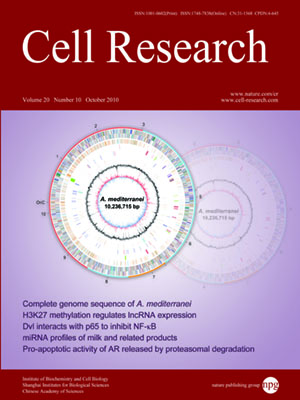
Volume 20, No 10, Oct 2010
ISSN: 1001-0602
EISSN: 1748-7838 2018
impact factor 17.848*
(Clarivate Analytics, 2019)
Volume 20 Issue 10, October 2010: 1096-1108
ORIGINAL ARTICLES
Complete genome sequence of the rifamycin SV-producing Amycolatopsis mediterranei U32 revealed its genetic characteristics in phylogeny and metabolism
Wei Zhao1,*, Yi Zhong1,*, Hua Yuan1,*, Jin Wang2,*, Huajun Zheng3,4, Ying Wang1, Xufeng Cen1, Feng Xu1, Jie Bai4, Xiaobiao Han1, Gang Lu3, Yongqiang Zhu3, Zhihui Shao1, Han Yan1, Chen Li1, Nanqiu Peng1, Zilong Zhang1, Yunyi Zhang1, Wei Lin1, Yun Fan1, Zhongjun Qin1, Yongfei Hu5, Baoli Zhu5, Shengyue Wang3,4, Xiaoming Ding4 and Guo-Ping Zhao1,2,3,4
1Key Laboratory of Synthetic Biology, Institute of Plant Physiology and Ecology, Shanghai Institutes for Biological Sciences, Chinese Academy of Sciences, Shanghai 200032, China
2Department of Microbiology and Li Ka Shing Institute of Health Sciences, The Chinese University of Hong Kong, Prince of Wales Hospital, Shatin, New Territories, Hong Kong SAR, China
3Shanghai-MOST Key Laboratory of Disease and Health Genomics, Chinese National Human Genome Center at Shanghai, Shanghai 201203, China
4State Key Laboratory of Genetic Engineering, Department of Microbiology, School of Life Sciences, Fudan University, Shanghai 200032, China
5CAS Key Laboratory of Pathogenic Microbiology and Immunology, Institute of Microbiology, Chinese Academy of Sciences, Beijing 100101, China
Correspondence: Guo-Ping Zhao, Xiaoming Ding, Shengyue Wang,(gpzhao@sibs.ac.cn; xmding74@fudan.edu.cn; wangsy@chgc.sh.cn)
Amycolatopsis mediterranei is used for industry-scale production of rifamycin, which plays a vital role in antimycobacterial therapy. As the first sequenced genome of the genus Amycolatopsis, the chromosome of strain U32 comprising 10 236 715 base pairs, is one of the largest prokaryotic genomes ever sequenced so far. Unlike the linear topology found in streptomycetes, this chromosome is circular, particularly similar to that of Saccharopolyspora erythraea and Nocardia farcinica, representing their close relationship in phylogeny and taxonomy. Although the predicted 9 228 protein-coding genes in the A. mediterranei genome shared the greatest number of orthologs with those of S. erythraea, it was unexpectedly followed by Streptomyces coelicolor rather than N. farcinica, indicating the distinct metabolic characteristics evolved via adaptation to diverse ecological niches. Besides a core region analogous to that common in streptomycetes, a novel 'quasi-core' with typical core characteristics is defined within the non-core region, where 21 out of the total 26 gene clusters for secondary metabolite production are located. The rifamycin biosynthesis gene cluster located in the core encodes a cytochrome P450 enzyme essential for the conversion of rifamycin SV to B, revealed by comparing to the highly homologous cluster of the rifamycin B-producing strain S699 and further confirmed by genetic complementation. The genomic information of A. mediterranei demonstrates a metabolic network orchestrated not only for extensive utilization of various carbon sources and inorganic nitrogen compounds but also for effective funneling of metabolic intermediates into the secondary antibiotic synthesis process under the control of a seemingly complex regulatory mechanism.
Cell Research (2010) 20:1096-1108. doi:10.1038/cr.2010.87; published online 22 June 2010
FULL TEXT | PDF
Browse 2222


